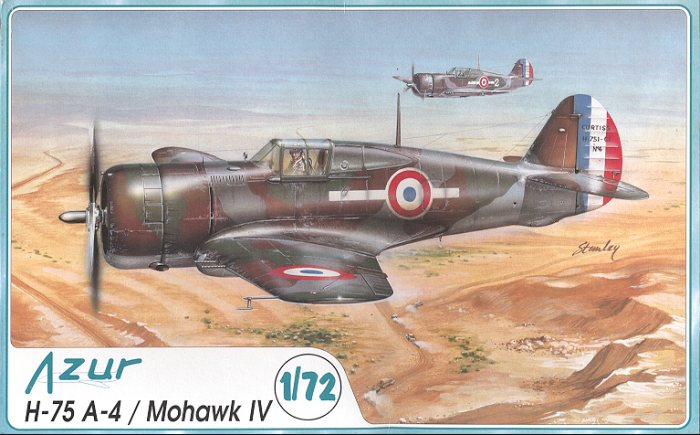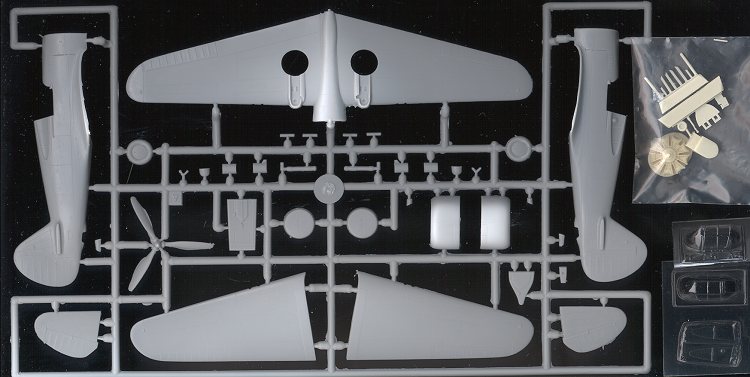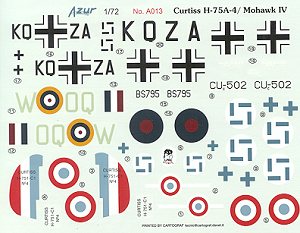
|
KIT: |
Azur 1/72 Hawk 75A-4/Mohawk IV |
|
KIT # |
013 |
|
PRICE: |
$15.98 |
|
DECALS: |
Four Aircraft; See Review |
|
REVIEW & |
|
|
NOTES: |
Multimedia short run kit |

|
HISTORY |
Though not the first mass-produced, low-wing, all-metal, retractable landing gear fighter for the USAAC (that goes to the P-35), the P-36 and derivatives was the aircraft that made Curtiss rich. This was due to a large USAAC order as well as equally large orders from France and other countries. The Hawk 75 was basically available with two engines. One was the 14 cylinder Twin Wasp and the other the 9 cylinder Cyclone.
Most of the initial production aircraft for the USAAC and those French versions that saw combat in 1940 were powered by the R-1830 Twin Wasp. This engine had more power than the Cyclone and was in a longer cowling that that of the Cyclone. However some of this power was taken up by the slightly greater weight of the Twin Wasp. These French aircraft were designated Hawk 75 A-1 and A-2 by the Curtiss folks.
The R-1820 Cyclone engined versions were the Hawk 75 A-3/A-4 and A-6. The Hawk 75 A-4 aircraft were ordered by France once the war had gotten under way and few were actually delivered before France capitulated. A similar version, the Hawk 75 A-6 was ordered by Norway and some of those were in country when it was overrun by the Germans. The result was that these French and Norwegian aircraft had a number of examples end up in places other than were they were originally intended. The undelivered aircraft were sent to England, but the Brits had better types in service already so they were given to the South Africans and sent to the Far East. Also sent to the Far East were a number bought by the Dutch for their East Indies colonies.
Those not destroyed in France and Norway were used by the Germans as fighter trainers and a number of these were sold to Finland where they were used with great effect by the Finns in the Continuation War with the Russians.
|
THE KIT |

Azur kits are designed in France, but molded and boxed in the Czech Republic by MPM. As a result, they look very similar to most Czech short run models. This particular kit has fine engraved panel lines with some cockpit sidewall detail. There are large ejector pin stubs that need to be removed from all the large parts like fuselage, wings and cowling. The rest of the kit is devoid of these marks. There is also some flash on most of the parts, but that should be easy to clean up.
There are no photo etched bits, but some resin pieces. These pieces are for the engine, some cockpit components, tail wheel and gear strut braces. There are also two vacuformed canopies as some versions have different canopies than others.
Instructions offer eight construction steps and are quite adequate to the job. There are color call-outs during construction with no specific paint brands given. Decals are by Cartograf in Italy and are very well done. Both the Finnish roundels and German swastikas are several bits so as not to offend the squeamish.
 There are four different
aircraft that you can do with the kit decals. One is a French Hawk of the Vichy
Air Force circa 1942 in North Africa. This is before the yellow and red cowlings
and tails. Next is a Luftwaffe fighter trainer from 1940/41 in overall RLM 02
grey. The third example is a British Mohawk IV from 5 Squadron in India around
1942 in green and grey. Finally, there is the Finnish AF version from July
1941. For those of you who have the Tally Ho decals, you can do a Dutch East
Indies version as well. This gives you a bunch of choices.
There are four different
aircraft that you can do with the kit decals. One is a French Hawk of the Vichy
Air Force circa 1942 in North Africa. This is before the yellow and red cowlings
and tails. Next is a Luftwaffe fighter trainer from 1940/41 in overall RLM 02
grey. The third example is a British Mohawk IV from 5 Squadron in India around
1942 in green and grey. Finally, there is the Finnish AF version from July
1941. For those of you who have the Tally Ho decals, you can do a Dutch East
Indies version as well. This gives you a bunch of choices.
Now for the big question; did we really need another 1/72 Hawk 75/P-36. Well it all depends on how you look at it. First of all, the previous kits by Heller and Monogram were for the Twin Wasp version. Sure, there was an engine conversion by DB, but that may not be available to all. Oddly, there is another Mohawk IV kit that was just released by AML. Whether this is the same kit or not, I can't say. Anyway, the Azure kit appears to be rather well done and anyone with experience in the genre will have no problems assembling a very nice model from this kit.
If you would like your product reviewed fairly and quickly by a site that has over 1,300 visits a day, please contact me or see other details in the Note to Contributors.